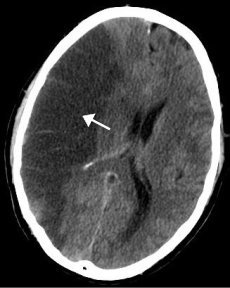
Back Beroerte Afrikaans Schlaganfall ALS Accident vascular cerebral AN سكتة دماغية Arabic ষ্ট্ৰ'ক Assamese Accidente cerebrovascular AST İnsult Azerbaijani سکته AZB Инсульт Bashkir Insūlts BAT-SMG
| Stroke | |
|---|---|
| Classification and external resources | |
 | |
| ICD-10 | I61.-I64.ner |
| ICD-9 | 434.91 |
| OMIM | 601367 |
| DiseasesDB | 2247 |
| MedlinePlus | 000726 |
| eMedicine | neuro/9 emerg/558 emerg/557 pmr/187 |
| MeSH | D020521 |
A stroke is an illness in which part of the brain loses its blood supply. This can happen if an artery that feeds blood to the brain gets clogged, or if it tears and leaks.
A stroke is when there is a lack of blood flow to the brain. There are two types of strokes. One is when there is a blood clot blocking the artery. The other type of stroke is when a blood vessel bursts and there is blood moving around freely in the brain.[1]
A stroke is the rapid loss of brain function(s) due to disturbance in the blood supply to the brain. This can happen because of ischemia (lack of blood flow) caused by blockage (thrombosis, arterial embolism), or a haemorrhage (leakage of blood).[2]
As a result, the affected area of the brain cannot work properly. Symptoms might include: hemiplegia (an inability to move one or more limbs on one side of the body), aphasia (inability to understand or use language), or an inability to see one side of the visual field.[3]
A stroke is a medical emergency. It can cause permanent damage. If it is not quickly treated, it may lead to death. It is the third most common cause of death and the most common cause of disability for adults in the United States and Europe.
Strokes happen on both the left and right side of the brain. When a stroke happens on the left side of someone’s brain, it affects the right side of the body. It can also cause problems with the patient’s speech and language. If a stroke affects the right side of the brain, it affects the left side of the body. It also changes patient’s spatial (relating to space) perceptions. Getting a stroke on the right side of the brain can also cause people to not acknowledge their illness. Patients behave impulsively and neglect the side of their body.[4]
Factors that increase the risk of a stroke include old age, high blood pressure, a previous stroke, diabetes, high cholesterol, smoking, atrial fibrillation, migraine with aura, and thrombophilia (a tendency to thrombosis). Of those factors, the most easy to fix are high blood pressure and smoking.
- ↑ Stroke; Overview. N.p.: GALE Cengage Learning, n.d. Health and Wellness Resource Center. Web. 22 Feb. 2016.
- ↑ Sims NR, Muyderman H (September 2009). "Mitochondria, oxidative metabolism and cell death in stroke". Biochimica et Biophysica Acta (BBA) - Molecular Basis of Disease. 1802 (1): 80–91. doi:10.1016/j.bbadis.2009.09.003. PMID 19751827.
- ↑ Donnan GA; Fisher M; Macleod M; Davis SM (May 2008). "Stroke". Lancet. 371 (9624): 1612–23. doi:10.1016/S0140-6736(08)60694-7. PMID 18468545. S2CID 208787942.
- ↑ Blaser, Larry. "Stroke." The Gale Encyclopedia of Science. Ed. K. Lee Lerner and Brenda Wilmoth Lerner. 5th ed. Farmington Hills, MI: Gale, 2014. Student Resources in Context. Web. 22 Feb. 2016.
© MMXXIII Rich X Search. We shall prevail. All rights reserved. Rich X Search